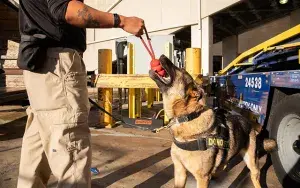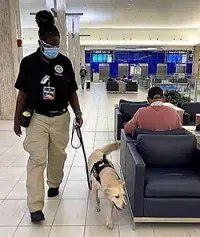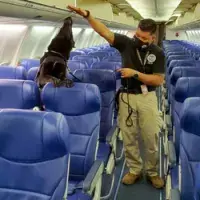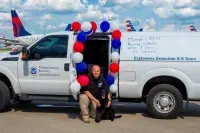
Over 1,000 canine teams are in action at TSA, and their work is never done.
Andrew Hotinger, one of the agency’s headquarters canine coordinators and National Explosives Detection Canine Team Program social media consultant, said TSA canine jobs are open to all TSA employees and U.S. citizens, but if you are interested in a canine career, be prepared to make a lifelong commitment to your dog.
“We look for people driven by the mission and willing to put in significant time to care for their canine,” said Hotinger. “The handler must be willing to care for the canine 24/7 at work and home. The length of initial training away from home (several months) is a significant consideration. Employment as a canine handler is contingent upon TSA prescreening, physical abilities and successful initial training. Maintaining employment requires being successful in numerous periodic assessments and annual evaluations, both scheduled and covert.”
However, if you talk with most canine handlers, the job is the most rewarding they have experienced.
“This is the only program in TSA that pairs two living beings together to be successful,” Hotinger noted. “It is unique within TSA and needs to be viewed and administered separately, with specific parameters that do not exist in more conventional operations.”
He said regimented training is the backbone to being successful. It begins at the Canine Training Center at Joint Base San Antonio Lackland in San Antonio, Texas, long before the handler arrives for training. That training helps the handler learn how to work in tandem with their partner and understand their specific behavioral traits.
“We say 80% of the work is done by the canine and 20% by the handler,” said Hotinger, “but it’s a true team effort. Both the handler and canine must be willing to learn, adapt and overcome as they progress. Traditional explosives detection canine training, which is typically geared toward our law enforcement partners, lasts 11 weeks, while training to become a passenger screening canine team takes 16 weeks.”
Law enforcement officers make up approximately 60% of the explosives detection canine teams, and the rest are TSA National Explosives Detection Canine Team Program Security Operations teams.
“Being a canine handler is incredibly demanding when done successfully,” said Hotinger. “Training never ends. Canines have to maintain proficiency on all trained odors and areas of operation as well as constantly expand their abilities to thwart emerging threats. Handlers must be able to read minute changes in their canine’s behavior to determine if their partner is responding to trained odor or something novel in the environment. The work is also physically demanding. Canine team training must be consistent with where the handlers may be asked to utilize their canines. This ensures proficiency of the team in real-life settings and includes working and training in all weather conditions.”
He said the dogs require very strict regimens to remain proficient. So what’s in it for them?
“Their toy/reward is their paycheck,” Hotinger replied. “They should only get it for successful work and motivation. They need to be very possessive of their reward for their payment to be meaningful.”
Hotinger said in general, TSA uses German shepherds, Belgian Malinois, Labrador retrievers and German shorthaired pointers, some of which may come from local shelters. Canines generally come into the system and start formal training when they’re 1 to 2 years old but may start earlier if they demonstrate aptitude.
If you’re interested in becoming a TSA canine handler, Hotinger said you should first consider your home life.
“Do you live in a location suitable to housing a working canine?” he asked. “Do you have other pets that would be conducive to having a working canine, family considerations, such as children, those who may fear dogs, health considerations such as allergies? Generally, working canines are kept separate from pets and are never treated as pets. Only the handler is able to care for the working canine at home.”
What happens when it’s time for a TSA canine to retire?
“The handler or supervisor will submit a request to retire the canine and generally will ask to adopt [the dog],” Hotinger said. “The determination is made by TSA’s National Explosives Detection Canine Team Program in consultation with the agency’s Canine Training Center and veterinary professionals as needed.”
If you’re interested in becoming a TSA canine handler, watch USAJOBS for announcements.
And remember, when you see a TSA canine team, they are always working hard to ensure the safety and security of everyone around them. Their job is never done!
To learn more about TSA canine training, check out this video.
Related stories: Furry friends flock to Tampa for Super Bowl LV
Keith Gray named 2020 TSA Canine Handler of the Year
TSA Blog: TSA’s National Explosives Detection Canine Program



